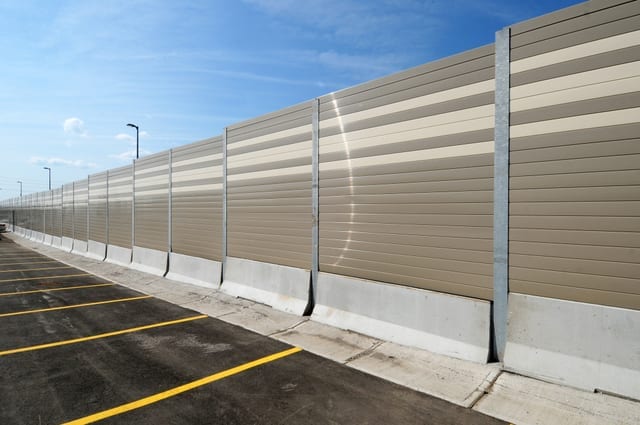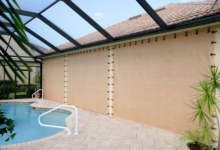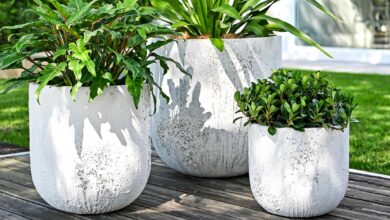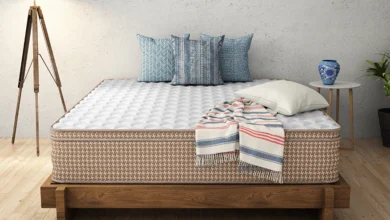
How Commercial Noise Barrier Walls Works
Airports, roadways, railways, and stadiums across Australia employ noise walls to block sound for the surrounding areas. Sound barriers have been in use since the 1970s, protecting residences against noise pollution from road traffic.
Many new types of noise barriers have developed over the years, but the design mechanisms and the science of noise barriers haven’t changed much. Noise walls may be built of various materials, including timber, concrete, aluminum, steel, acrylic sheeting, rubber mats, and masonry block.
Table of Contents
How Do Commercial Noise Wall Barriers Work?
The science of designing noise barriers is based on blocking sound rays traveling towards a certain receptor. Sound travels in waves. Noise barriers block the direct path of these waves, helping to reduce noise. They don’t completely block noise but the effective ones can reduce noise by at least 5 decibels. It’s also important to keep diffraction in mind when designing noise walls.
Noise barriers are also more effective in blocking higher frequencies. This is why traffic on the noise-walled freeway near your home has less treble and more bass from a distance.
How effective a noise barrier is depends on how much it forces sound waves to bend in order to reach the receiver, that is, residents in an adjacent building or customers at a nearby retail property.
Imagine a vehicle as a noise source. Noise radiates outward from the vehicle as pressure waves in all directions. Now suppose a commercial acoustic fencing company installs a noise wall along the edges of the motorway. How effective will the noise wall be in blocking noise from a property a few meters away?
The effectiveness of the noise barrier will depend on how much the top of the barrier cuts the line of sight between the receiving property and the sound source. A combination of different mechanisms goes into making modern noise walls quite effective against noise pollution.
Reflective Barriers
Reflective barriers are placed on the edge of heavy-traffic roads to reflect traffic noise. Some sound will still pass over the barrier. But overall noise is lower behind the barrier. These reflective barriers tend to be higher than other kinds of noise barriers.
Dispersive Barriers
These types of barriers have some surface patterns or carefully-planned inclination to disperse the noise upwards or downwards from its original path. Dispersive barriers are a special type of reflective barrier.
Absorptive Barriers
Some barriers absorb and dissipate sound wave pressure by allowing it to move through a carefully-designed passage or membrane. Materials with a high coefficient of absorption are preferred.
Noise Wall Guidelines
In Australia, government bodies offer design advice and guidelines on noise walls. Some of the takeaways from the authoritative literature include:
- Noise walls must relate well to the site, both in functionality and appearance
- Noise walls are most effectively located close to the source of the noise, except when the source is located in a cutting where a noise wall will be more effective on top of the cutting.
- The height of the barrier should be enough to dissect the line between a point a meter above the road surface and a point 1.5m above the floor of a resident next to the road.
- Two-story residences shouldn’t be ignored.
- On multi-lane roads, higher walls can reduce noise from the furthest lanes. But aesthetic concerns and cost issues may constrain the height. A second barrier in the median strip may be a possible solution.
- Parallel walls will need absorptive treatment to reduce reflected noise.
- Simple noise mounds of earth in rural or suburban areas are highly effective solutions that are also aesthetic.
- Noise walls must be continuous to be effective.
Types Of Commercial Noise Walls
Timber walls: Some manufacturers design acoustic walls from high-quality timber. The regulatory standard for the density of noise walls in Australia is 10 kg per cubic meter.
The sound-absorbing properties of specially-treated plywood are enhanced with enveloping.
It’s common to use 25 to 33 mm ply to achieve wall densities of at least 15 to 21 kg per cubic meter. Acoustic plywood fencing can help to reduce noise transmission.
Timber fencing tends to have medium noise barrier properties. They are best suited for main roads with high traffic, freeways, schools, commercial properties next to residential areas, industrial properties, shopping neighbourhoods, and railway sites.
Pinewood timber makes excellent acoustic fencing for heavy or light use. With treated pine and a special proprietary design, manufacturers are able to design walls with minimum densities of 18 to 20 kg per cubic meter for heavy-duty noise reduction. These walls are fitted with 38mm pine palings treated to be effective against sound. Lighter acoustic fences typically have wall densities of 12.2 kg per cubic meter and use 24mm pine palings.
Metal walls: Colourbond sheets of thicknesses between 0.42mm and 0.6mm make aesthetically pleasing noise barriers made to relevant Australian standards. These zincalume steel walls are corrosion-resistant, sound-absorbing, durable, and low maintenance, lasting longer than timber walls. The double skin galvanised steel and various thicknesses make Colourbond highly durable.
Colourbond noise barriers are great for use in new housing estates and at industrial sites. Colourbond sheets can be built to specifications, as needed.
Heavy-Duty Ply And Steel Walls
Some of the best noise reduction is offered by commercial noise walls designed and built by acoustic engineers to meet all the sound transmission requirements and coefficients of absorption with 31 mm plywood. Steel beams and precisely-laid joins help to reduce noise transmission at great lengths.
Final Thoughts
Commercial noise wall barriers are of various types. Urban designers in collaboration with noise engineers and consultants design noise walls for specific use cases. These are customised and careful design control ensures that the design is near-perfectly implemented in the construction phase.
You may have to make some compromises when it comes to reconciling local noise problems and the greater good of the community. For instance, in some areas views may be more important than noise reduction, in which case compromises may be made.
But in general, a good commercial acoustic fencing is consistent along its length, related to the site, elegant, and customised to the site. You can find commercial noise wall consultants to design a suitable wall for your site that will not only protect locals from noise pollution but also seamlessly blend in with the surroundings.








